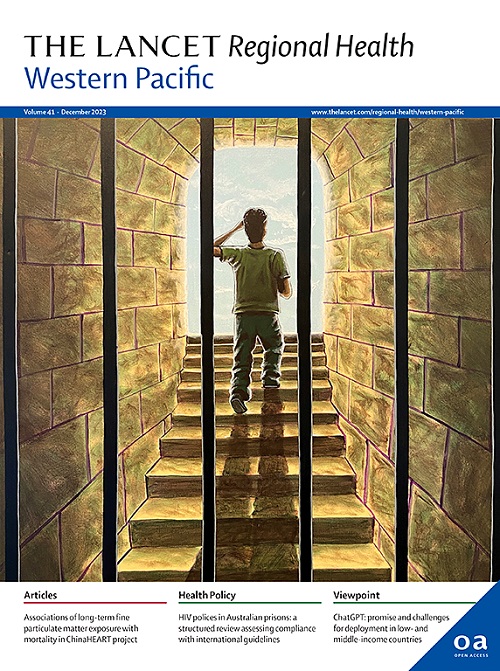评估柬埔寨疟疾高危流动人群中间日疟原虫血清学检测和治疗的技术可行性
IF 7.6
1区 医学
Q1 HEALTH CARE SCIENCES & SERVICES
引用次数: 0
摘要
柬埔寨的目标是到2025年消除疟疾,与世卫组织的湄公河疟疾消除规划保持一致。虽然消除恶性疟原虫已接近实现,但间日疟原虫的消除对该物种固有的挑战是由于出现了被称为催眠虫的休眠寄生虫阶段。提出了一种新的血清学方法来鉴定可能携带催眠虫的个体,这些个体应该接受适当的抗疟治疗:间日疟原虫血清学检测和治疗(PvSeroTAT)。本研究旨在确定PvSeroTAT方法在柬埔寨东部人口高度流动的疟疾流行社区的技术可行性。方法于2021年10月24日至2023年2月26日,在柬埔寨东部蒙多尔基里3个村庄的成年和青少年男性中连续进行两轮PvSeroTAT检测。在每一轮,从同意的参与者收集毛细血管血液样本用于间日疟原虫血清学和G6PD活性测定。G6PD正常的血清阳性参与者,然后按照柬埔寨治疗指南(0.25 mg/kg,持续14天)重新联系,提供抗催眠虫伯氨喹方案。在PvSeroTAT干预之前、期间和之后,在相同的三个村庄和另外三个没有实施干预的邻近对照村庄进行了评估间日疟原虫流行情况的横断面调查。研究结果表明,参与者的参与率很高,96%(456/477)的符合条件的个体至少参加了一轮PvSeroTAT。然而,只有63%参加第一轮PvSeroTAT的参与者同意参加第二轮。在PvSeroTAT的第一轮和第二轮中,分别有31%(101/327)和30%(98/334)的入组参与者血清阳性,其中82%(163/199)符合伯氨喹治疗的条件。所有163名血清阳性的符合条件的个体可以重新联系并给予伯氨喹治疗,96%的个体在10天内发生这种情况(157/163)。在第一轮PvSeroTAT之后,所有村庄(包括对照村)的间日疟原虫流行率总体上从7.7%降至2.7%。PvSeroTAT在柬埔寨疟疾流行地区社区内高流动性人群中的参与率和总体技术可行性非常有希望。PvSeroTAT与基于实验室的分析在柬埔寨是可行的,即使它在后勤上比使用即时检测更具挑战性。进一步研究了解社区对没有临床症状的检测和治疗方法的看法,对于制定有针对性的社区教育和认识材料,以提高对多轮检测和治疗干预措施的参与,将是重要的。PvSeroTAT干预措施得到了全球基金RAI3倡议的资助。横断面调查由美国国立卫生研究院国际疟疾研究卓越中心(ICEMR)亚太地区(U19AI129392)资助。本文章由计算机程序翻译,如有差异,请以英文原文为准。
Evaluating the technical feasibility of serological testing and treatment for Plasmodium vivax in mobile at-risk of malaria Cambodian populations
Background
Cambodia is targeting malaria elimination by 2025, aligning with the WHO's Mekong Malaria Elimination program. While elimination of Plasmodium falciparum is nearly achieved, Plasmodium vivax elimination presents challenges inherent to this species due to the occurrence of dormant parasite stages, known as hypnozoites. A new approach has been proposed to serologically identify individuals likely carrying hypnozoites that should receive appropriate antimalarial treatment: P. vivax serological testing and treatment (PvSeroTAT). This study aims to determine the technical feasibility of a PvSeroTAT approach in malaria endemic communities with highly mobile populations in Eastern Cambodia.
Methods
From October 24th 2021 to February 26th 2023, two successive rounds of PvSeroTAT were conducted in adult and adolescent males in three villages of Mondolkiri, Eastern Cambodia. At each round, capillary blood samples were collected from consenting participants to be used for P. vivax serology and G6PD activity determination. Seropositive participants, who were G6PD normal, were then recontacted to be provided an anti-hypnozoite primaquine regimen following Cambodian treatment guidelines (0.25 mg/kg for 14 days). Cross-sectional surveys to evaluate P. vivax prevalence were conducted before, during and after the PvSeroTAT interventions in the same three villages and in three additional neighboring control villages where interventions were not implemented.
Findings
Participation was high, with 96% (456/477) of eligible individuals enrolled in at least one round of PvSeroTAT. However, only 63% of participants enrolled in the first PvSeroTAT round agreed to participate in the second round. In the first and second round of PvSeroTAT, 31% (101/327) and 30% (98/334) of enrolled participants, respectively, were seropositive and among those, 82% (163/199) were eligible for primaquine treatment. All 163 seropositive eligible individuals could be recontacted and offered a primaquine treatment, this occurred within 10 days for 96% of individuals (157/163). P. vivax prevalence decreased in all villages, including the control ones, after the first round of PvSeroTAT from 7.7% to 2.7% overall.
Interpretation
The participation rates and overall technical feasibility of PvSeroTAT in highly mobile individuals living within communities in malaria endemic areas of Cambodia were very promising. PvSeroTAT with a lab-based assay is feasible in Cambodia even if it is logistically more challenging than using point-of-care assays. Further studies to understand community perspectives about test and treat approaches in the absence of clinical symptoms will be important for the development of tailored community education and awareness material to improve participation in multiple rounds of test and treat interventions.
Funding
The PvSeroTAT interventions received funding from the Global Fund RAI3 initiative. Cross-sectional surveys were funded by the NIH International Centers of Excellence for Malaria Research (ICEMR) Asia–Pacific (U19AI129392).
求助全文
通过发布文献求助,成功后即可免费获取论文全文。
去求助
来源期刊

The Lancet Regional Health: Western Pacific
Medicine-Pediatrics, Perinatology and Child Health
CiteScore
8.80
自引率
2.80%
发文量
305
审稿时长
11 weeks
期刊介绍:
The Lancet Regional Health – Western Pacific, a gold open access journal, is an integral part of The Lancet's global initiative advocating for healthcare quality and access worldwide. It aims to advance clinical practice and health policy in the Western Pacific region, contributing to enhanced health outcomes. The journal publishes high-quality original research shedding light on clinical practice and health policy in the region. It also includes reviews, commentaries, and opinion pieces covering diverse regional health topics, such as infectious diseases, non-communicable diseases, child and adolescent health, maternal and reproductive health, aging health, mental health, the health workforce and systems, and health policy.
 求助内容:
求助内容: 应助结果提醒方式:
应助结果提醒方式:


